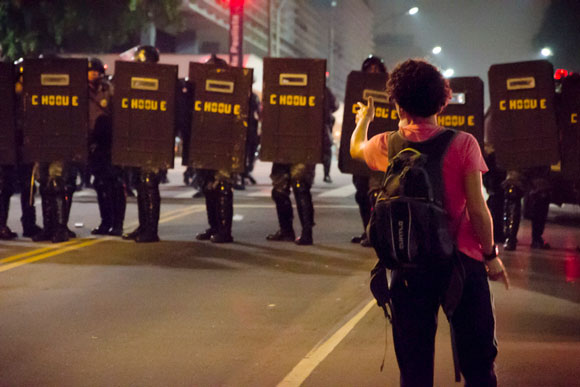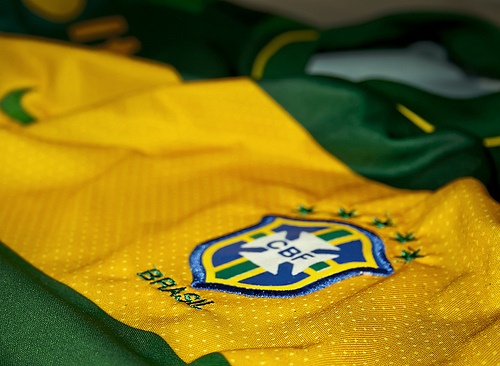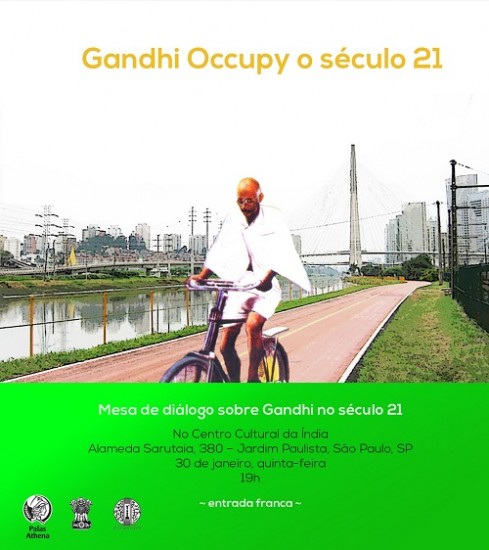 Protesters in Sao Paolo in June 2013. (Image credit: Ricardo Lisboa)
Protesters in Sao Paolo in June 2013. (Image credit: Ricardo Lisboa)As much as the average Brazilian may feel passionate about soccer, the preparation for the World Cup in Brazil has been exposing social differences. In the wake of the great popular mobilisation of June 2013, some Brazilians seem to be following suit to protest against the mega sport event to take place in 2014. Apparently, the disparity between brand new stadiums and the demeaning inefficiency of essential public services has been the main reasons for disappointment, especially for a people long disheartened by the malady of corruption in a country with a tax burden equivalent to 36 per cent of its GDP
The “Itaquerão” stadium may well be considered an emblematic example of the World Cup infrastructure social incongruity: a colossal venture built from scratch specially to host the opening of the event, situated on the eastern outskirts of the city of São Paulo in an area that for too long has been in need of public investment for the improvement of the quality of life of its residents. Six of the twenty-nine worst districts to live in in the city are within a 15 kilometres radius of the new venue, estimated to cost over 1 billion Brazilian reals, or US $430 million.
Is the population ready to undertake large nonviolent demonstrations during one of the biggest sport events on the planet, with the eyes of the world upon Brazil, without degenerating into senseless vandalism? And is the state willing to face the potential of such broad scale mobilisation in a constructive manner, without degenerating into arbitrary oppression?
Narratives of (in)security
Despite similar and considerable improvement in the last twenty years, wealth inequality is also still a reality and big problem. Lots of people live in the infamous favelas. There is a clear social divide, ever more shocking when it comes down to the morbidity of criminal statistics: the homicide difference between the white and the African-Brazilian community is of 70 per cent.
A kind of social paranoia has developed around state-sponsored security discourse, one more often than not legitimised by a population which still takes its cues from the Military Regime rationale, propagandising a constant need for punishment as the most effective way to tackle the criminality issue.
The Brazilian prison population is the fourth largest in the world, with 550,000 inmates. Confined to an incarceration system that barely meets any minimum standard of dignity, public order, preventive and immediate crime response are carried out by police departments still based on a military infrastructure. Military Police ‘special operations’ in slum areas are commonplace: usually raids carried out by so called ‘elite squads’ that end up with arrests, drugs and weapons apprehension – and dead civilians, frequently portrayed by the authorities responsible as possessing criminal records. Such operations are nonetheless often boasted of as being conducted ‘by the book’.
Notwithstanding that there are more people being jailed, together with a more coercive stance by law enforcement agencies in general, there is a simmering belief, very much propelled by an undeniable inefficiency of crime investigation departments, deeming impunity as the main reason for high crime rates. This leads to a vicious cycle, fuelled by a sense of collective fear and media sensationalism, that propagates social distrust. This inevitably leads to the popular endorsement of such militarised public discourses of (in)security, and demonstrates how much the state security apparatus is still reliant on a notion of repression as the most adequate way to deal with social conflicts.
The winds of change
 Image credit: Thomas
Image credit: ThomasOn the 13 June, video and photo cameras captured peaceful protesters on the main avenue of the city of Sao Paulo, being violently repressed by the police. Some people were allegedly arrested on very feeble legal grounds. A photographer from a mainstream media network was hit in the face by non-lethal ammunition and ended up losing his left eye. An outcry against police brutality immediately followed, leading to a more political engagement with the whole issue by government authorities. On the 17 June, when the movement first experienced a more national articulation, a crowd from all walks of life occupied the streets in one of the most affluent commercial areas of the city, only to be escorted by a line of uniformed police officers with empty holsters: an extremely relevant and symbolic outcome yet to be properly appreciated. On the 19 June, the mayor of Sao Paulo backed up on the bus fare increase, with many municipalities throughout the country following.
Events of private and state property vandalism, looting and violent reaction against the police tainted some of the demonstrations. As clear as those sporadic distortions played out completely against the mainstream movement, which has stuck to the powerful legitimacy of a nonviolent struggle, it has served to bolster the security discourse, with more conservative voices from both civil society and policy makers relying on the Military Police as the most adequate means to ensue ‘public order’.
This has given room to expressions contrary to the nonviolent ideal. Organised groups deliberately targeting property have appeared – most notoriously the so called Black Blocs – and arson has taken place on public buses.
In response to this, and with the start of the World Cup fast approaching, there are talks in order to try and speed up the passing of a bill in the Brazilian Congress that seeks to establish crimes and administrative sanctions to enhance security for the event – including, among other things, punishing terrorism, defined under extremely broad terms, with possible jail sentences of up to 30 years.
Fair play
In the city of São Paulo, a number of civil society movements have been practicing and disseminating a culture of peace and the transformation of conflict through nonviolent means.
The Institute for the Defense of the Right to be Defended, an organisation that started in the 1980s by well-established lawyers, has contributed pro bono to a wide array of activities, including some directly related to peacebuilding, working on human rights projects with inmates and students of a high schools in socially vulnerable regions. Both programs are based on a philosophy of dialogical exchange, aiming to promote a constructive and participative agenda, tending to the needs and peculiarities of each environment.
Specifically developed as a centre for Peace Studies inspired by Gandhian philosophy, the Palas Athena Institution, a UNESCO partner, is a hub for the diffusion of peace cultures through educational and artistic activities. It has held dialogue events open to the public, including one entitled ‘Gandhi Occupy: the 21st Century’, with the participation of representatives of four different organisations directly engaged in the popular movements that have been questioning aspects of the World Cup.
 Image credit: Palas Athena Association
Image credit: Palas Athena AssociationOn the winding but inevitably fruitful road of nonviolence, decisive steps by a people, still struggling with its historical traumas since the oppressive European coloniser first set foot on its resourceful land, will ultimately lead to mastering the potential of such a powerful and creative weapon of protest for transformation.
Civil society has witnessed the overwhelming benefits of civil resistance. A young leadership ought to be inspired by it, calling for a disciplined and responsible militancy to protest as passionately as Brazilians have traditionally supported the national soccer squad. Major elections will take place in 2014. Big political offices are at stake and a new crop of politicians is emerging: the Brazilian democracy longs for a qualitative leap of participative dialogue to help close some of the inequality gaps, with a clear opportunity to leave the authoritarian and elitist burden behind. Maybe now is as good a historical moment as ever to revive the beautiful Brazilian nonviolent legacy to its fullest.







